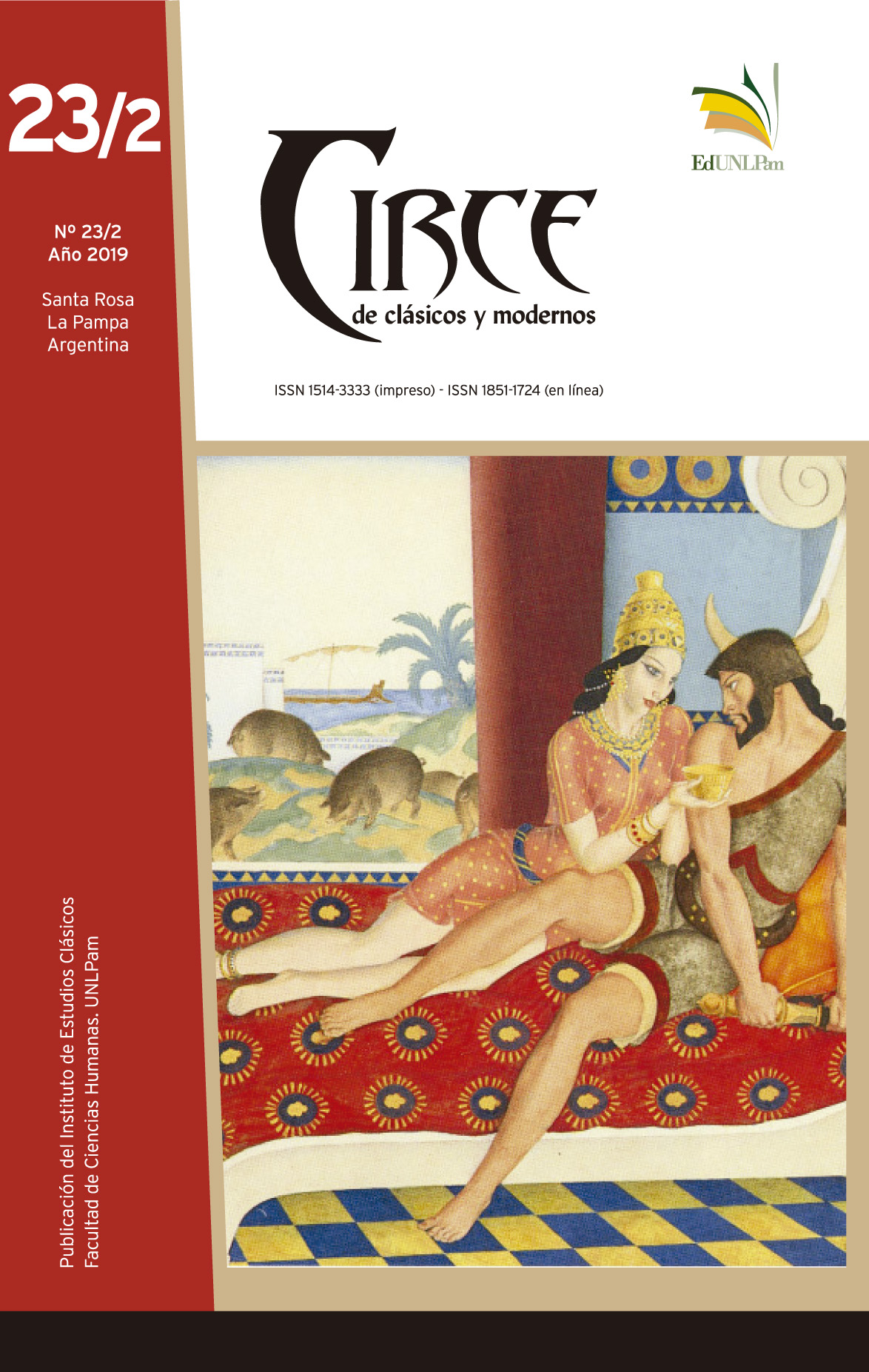¿Adulescens amator? Ethos y comicidad en la configuración discursiva de Pánfilo en Hecyra de Terencio
Palabras clave:
Terencio, Hecyra, Pánfilo, adulescens amator, comicidadResumen
Aunque el rasgo amator define al adulescens desde el punto de vista del código de la palliata, el presente trabajo se propone demostrar que parte de la comicidad de este personaje reside en el hecho de que esta es una rutina que Pánfilo no desarrolla más que a un nivel discursivo, que no se condice con sus acciones en escena. Un segundo aspecto en el que reposa su comicidad estriba en que Pánfilo no es el típico adulescens indeciso de palliata, pues, paradójicamente, con su decisión de no actuar, termina capitaneando el desarrollo de la trama.
Descargas
Citas
Kauer, R. y Lindsay, W. (eds.) (1958). P. Terenti Afri. Comoediae (Recognoverunt brevique adnotatione critica instruxerunt, supplementa apparatus curavit O. Skutsch).
Oxford: Clarendon Press. Stella, S. (introduzione e commento) (1980). P. Terenzio Afro. Hecyra. Milano: Signorelli.
Bibliografía citada
Amossy, R. (2010). La présentation de soi. Ethos et identité verbale. Paris: Presses universitaires de France.
Anderson, W.S. (2000). “The Frustration of Anagnorisis in Terence’s Hecyra” en Dickison, S.K.; Hallett, J.P. (eds.). Rome and Her Monuments: Essays on the City and Literature of Rome in Honor of Katherine A. Geffcken, Wauconda, IL.: Bolchazy-Carducci; 311-324.
Anderson, W.S. (2002). “Resistance to Recognition and ‘privileged recognition’ in Terence”: Classical Journal 98; 1-8.
Attardo, S. (1994). Linguistic Theories of Humor. Berlin- New York: Mouton de Gruyter.
Austin, J. C. (1921). The Significant Name in Terence. Chicago: University of Illinois Press.
Cabrillana, C. (2000). “Virtualidades del espacio extra-escénico en la Hecyra de Terencio”: Pallas 54; 269-287.
Duckworth, G. (1952). The Nature of Roman Comedy. A Study in Popular Entertainment. Princeton: Princeton University Press. Dupont, F.; Letessier, P . (2011). Le Théâtre Romain. Paris: Armand Colin.
Espigares Pinilla, A. (2008). “Claves para la historia de un cultismo: «honesto». I. Antigüedad y Edad Media”: Cuadernos de Filología Clásica. Estudios Latinos 28/2; 65-81.
Faure-Ribreau, M. (2012). Pour la beauté du jeu. Paris: Les Belles Lettres. Gellar-Goad, T. H. M. (2013). “Religious Ritual and Family Dynamics in Terence” en Augoustakis, A.; Traill, A. (eds.). A Companion to Terence. Oxford: Blackwell; 156-174.
Goldberg, S. M. (1986). Understanding Terence. Princeton: Princeton University Press. Habinek, T. N. (1998). The Politics of Latin Literature. Writing, identity, and empire in Ancient Rome. Princeton: Princeton University Press.
James, S. L. (2013). “Gender and Sexuality in Terence” en Augoustakis, A.; Traill, A. (eds.). A Companion to Terence. Oxford: Blackwell; 175-194.
Konstan, D. (1983). Roman Comedy. Ithaca & London: Cornell University Press. Knorr, O. (2013). “Hecyra” en Augoustakis, A.; Traill, A. (eds.). A Companion to Terence. Oxford: Blackwell; 295-317.
Lentano, M. (1991). “Patris pudor/matris pietas. Aspetti terminologici e valenze antropologiche del rapporto generazionale in Terenzio”: Aufidus 15; 15-40.
McGarrity, T. (1980). “Reputation vs. reality in Terence’s Hecyra”: Classical Journal 76/2; 149-156. Morton Braund, S. (2005). Satiric Advice on Women and Marriage. From Plautus to Chaucer. Ann Arbor: University of Michigan Press.
Papaioannou, S. (2014). “Terence’s literary self-consciousness and the anxiety of Menander’s influence” en Papaioannou, S. (ed.). Terence and Interpretation. Newcastle upon Tyne: Cambridge University Press; 95-118.
Parker, H. N. (1996). “Plautus vs. Terence: Audience and Popularity ReExamined”: The American Journal of Philology 117/4; 585-617.
Penwill, J. L. (2004). “The Unlovely Lover of Terence’s Hecyra”: Ramus 33/12; 130-149.
Perelli, L. (1973). II teatro rivoluzionario di Terenzio. Firenze: La nuova Italia.
Rosivach, V. J. (1998). When a young man falls in love. The Sexual Exploitation of Women in New Comedy. London & New York: Routledge.
Shelton, J. A. (1998). As the Romans Did: A Sourcebook in Roman Social History. New York: Oxford University Press. Slater, N. W. (1988). “The Fiction of Patriarchy in Terence’s Hecyra”: Classical World 81; 249-260.
Suárez, M. (2019). “El atractivo cómico de Hecyra” en Diolaiti, E.; Suárez, M. (comp.), Comicidad, Humor y Performance en Terencio. Colección Textos y Estudios. Instituto de Filología Clásica, Facultad de Filosofía y Letras, UBA (en prensa).
Zoccola, V. (2007). “L’ironia nell’Hecyra di Terenzio”: Orpheus 28; 265-301.
Publicado
Número
Sección
Licencia
Los autores que tengan publicaciones con esta revista, aceptan los términos siguientes referidos a los derechos de autor/a:
1. Los autores/as conservarán sus derechos de autor y garantizarán a la revista el derecho de primera publicación de su obra, el cuál estará simultáneamente sujeto a la Licencia de reconocimiento de Licencia Creative Commons Atribución-NoComercial-CompartirIgual 4.0 Internacional (http://creativecommons.org/licenses/by-nc-sa/4.0/). que permite a terceros compartir la obra siempre que se indique su autor y su primera publicación esta revista. El autor es el titular del copyright.
2. Los autores/as podrán adoptar otros acuerdos de licencia no exclusiva de distribución de la versión de la obra publicada (postprint) siempre que se indique la publicación inicial en esta revista. La cesión de derechos no exclusivos implica también la autorización por parte de los autores para que el trabajo sea depositado en el repositorio institucional y difundido a través de las bases de datos que el editor considere adecuadas para su indización, con miras a incrementar la visibilidad de la publicación y de sus autores.
3. Se permite y recomienda a los autores/as difundir su obra a través de Internet antes y durante el proceso de envío, lo cual puede producir intercambios interesantes y aumentar las citas de la obra publicada.







.jpg)









2.png)



